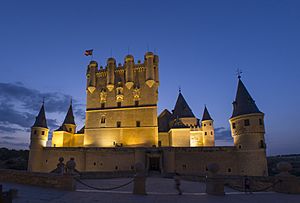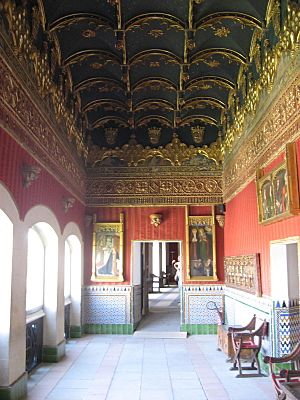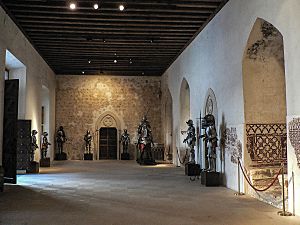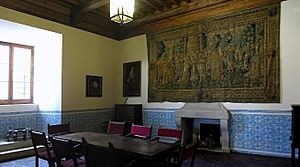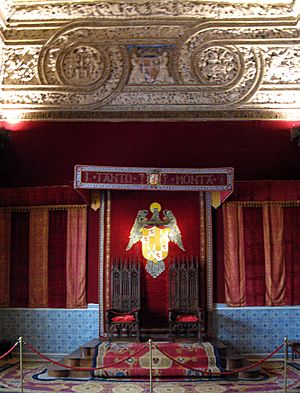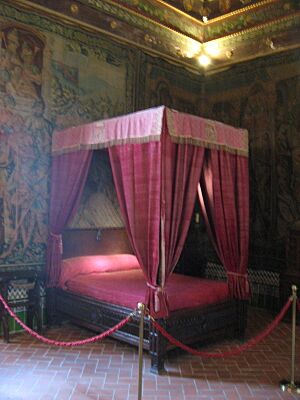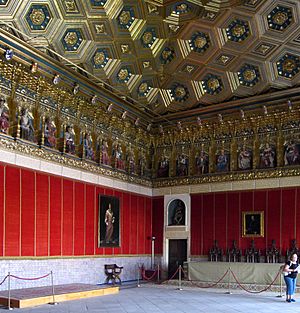Alcázar of Segovia facts for kids
Quick facts for kids Alcázar of Segovia |
|
|---|---|
| Segovia, Spain | |
 |
|
| Coordinates | 40°57′09″N 4°07′57″W / 40.9525°N 4.1325°W |
| Type | Alcázar |
| Site information | |
| Operator | Patronato del Alcázar de Segovia |
| Open to the public |
Yes |
| Official name: Alcázar of Segovia | |
| Type: | Cultural |
| Criteria: | i, iii, iv |
| Designated: | 1985 (9th session) |
| Part of: | Old Town of Segovia and its Aqueduct |
| Reference #: | 311 |
| Region: | Europe and North America |
| Official name: Alcázar | |
| Type: | Non-movable |
| Criteria: | Monument |
| Designated: | 3 June 1931 |
| Reference #: | RI-51-0000861 |
The Alcázar of Segovia (which means "Segovia Castle") is a famous medieval castle in Segovia, Spain. It stands on a rocky hill where two rivers meet. Its unique shape, like the front of a ship, makes it one of Spain's most recognizable castles.
The Alcázar was first built around the 11th century as a strong fort. Over time, it became a royal palace for 22 kings and queens. It also served as a prison, a military school, and an artillery college. In 1985, the Old Town of Segovia, including the Alcázar, became a UNESCO World Heritage Site. Today, it is a museum and a place where old military records are kept.
Contents
- History of the Alcázar
- What the Alcázar Looks Like
- Tower of John II of Castile
- Inside the Rooms
- Hall of the Old Palace
- Hall of the Fireplace
- Throne Room (Salón del Solio)
- Hall of the Galley (Sala de la Galera)
- Hall of las Piñas (Sala de las Piñas)
- Royal Chamber
- Hall of the Kings (Sala de los Reyes)
- Room of the Belt
- Chapel (Capilla)
- Weapons or Armory Room
- Museum of the Royal College of Artillery (Museo del Real Colegio de Artillería)
- See also
History of the Alcázar
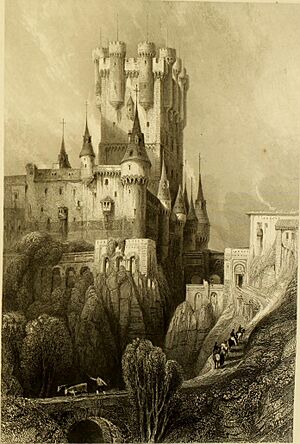
The Alcázar of Segovia began as a Roman fort. But most of that old structure is gone. The castle was later built by the Almoravid dynasty, a group from North Africa. Not much of their original work in Spain survived.
The first mention of this castle was in 1120. This was about 32 years after Christian forces took over Segovia. King Alfonso VI had reconquered lands during the Reconquista.
In 1258, a big thunderstorm caused a fire. It destroyed several rooms in the castle. This led to many years of rebuilding by different kings.
The exact shape of the Alcázar was not known until the time of King Alfonso VIII (1155–1214). Before him, the Muslim-era fort was likely just a wooden structure on Roman foundations. King Alfonso VIII and his wife, Eleanor of England, made the Alcázar their main home. They started building the stone castle we see today.
From the 13th century, the Alcázar was a favorite home for royalty. This brought a lot of support to Segovia. Most of the current building was constructed during this time by the House of Trastámara family.
King Alfonso X had parts of the Alcázar rebuilt after a collapse in 1258. He also built the Hall of Kings for Parliament meetings. King John II of Castile added the "New Tower," now known as the John II tower.
In 1474, the Alcázar was important for Queen Isabella I. When King Henry IV died, Isabella quickly went to the Alcázar for safety. She was crowned Queen of Castile and León there the next day.
King Philip II made big changes after marrying Anna of Austria. He added the sharp, pointed slate spires. These spires made the castle look like those in central Europe. In 1587, an architect named Francisco de Morar finished the main garden and other areas.
In 1623, Prince Charles visited the Alcázar. He was shown the Galley Room, which had symbols of Catherine of Lancaster. There was a special evening party with knights.
King Charles III of Spain (1759–1788) brought back the Royal College of Artillery. He chose the Alcázar as the home for this military academy. It opened in 1764 and became a symbol of progress in military education.
On March 6, 1862, another fire damaged the castle. It destroyed the beautiful ceilings of the private royal rooms. Luckily, old drawings helped restore the castle to its original look.
The damaged roofs were slowly fixed by 1882. This was possible thanks to drawings made by José María Avrial in 1839. In 1896, King Alfonso XIII gave the Alcázar to the Ministry of War. It continued to be a military college.
In 1951, the Board of Trustees of the Alcázar of Segovia was created. Their job is to protect the castle's history, art, and culture. They make sure it stays a royal castle, a military area, and a military academy.
What the Alcázar Looks Like
The outside of the castle has a special courtyard, a moat (a ditch filled with water), a drawbridge, and a strong keep (main tower). Inside, you can visit a chapel and several grand rooms. These include the Throne Room, the Galley Room, and the Hall of Kings.
The castle sits on a hill with four towers. Its halls have rounded ceilings and twin windows. Inside, the rooms are beautifully decorated by Mudéjar artists.
Today, the Alcázar has an Armory Museum. It also holds the General Military Archive of Segovia. This is the oldest historical archive of the Spanish Armed Forces.
Tower of John II of Castile

King John II of Castile (1406–1454) built his tower in the early 15th century. It shows a style called Spanish Gothic architecture. It also has influences from Islamic art, like a special arch found during repairs.
The tower has a large viewing terrace at the top. Two steep spiral staircases with 156 steps lead up to it. There's a guard room at the end of the first section.
Inside the Rooms
The inside of the Alcázar is as grand as the outside. Many rooms have beautiful decorations. These were made by Arabian workers in the 14th century.
Hall of the Old Palace
This room was built during the time of King Alfonso VIII of Castile. It still has the twin windows that lit up the old palace. The decorations between the windows came from a 13th-century house nearby. There is also 15th-century German armor on display.
Hall of the Fireplace
This room was arranged during the time of Philip II of Spain. The furniture is from the 16th century. You can see portraits of Philip II and Philip III on the walls. There's also a Flemish tapestry and a picture showing how the Alcázar looked before its roofs were changed.
Throne Room (Salón del Solio)
The Throne Room walls have portraits of different kings and queens. These were part of a collection ordered by Queen Isabella II of Spain. The portrait of Isabella I of Castile was painted by Madrazo, and Ferdinand II of Aragon's portrait was by Montañés.
This room was used for important events. These included welcoming foreign visitors, banquets, and musical shows. The room could be decorated with different objects, like fancy dishes and tapestries, to fit the event.
Hall of the Galley (Sala de la Galera)
Queen Catherine of Lancaster (1390–1406) ordered the building of the Hall of the Galley in 1412.
The room's name comes from its ceiling. It looks like an upside-down ship's hull.
The decorative border has two inscriptions. The top one is a prayer. The bottom one tells about the artwork in the hall.
There are two stained glass windows. One shows Henry III of Castile and his family. The second shows King Henry II of Castile and scenes of his time. A painting by Muñoz de Pablos shows the coronation of Isabella I of Castile as Queen.
Hall of las Piñas (Sala de las Piñas)
This room is named for the many pineapple-like designs on its ceiling. The stained glass window shows King Alfonso VII (1126–1157) with his daughter, Queen Berengaria of Castile (1217).
Royal Chamber
On its walls, you can see scenes of the family life of the Catholic Monarchs. The bed has a fancy cover woven with gold.
Hall of the Kings (Sala de los Reyes)
King Alfonso X (1252–1284) ordered the building of the Hall of the Kings. It has decorated ceilings. The upper parts of the walls are covered with a five-layer cloth.
The design of this hall was inspired by the Alhambra palace. King Henry IV of Castile (1454–1474) played a big part in its final look. It includes historical references, like the famous knight, El Cid.
King Henry IV wanted a gallery showing different rulers of Castile and León. This was to show the political power of the rulers in the 15th century. Similar images are found in the King’s Hall at the Alhambra. These images show political power and importance.
Philip II of Spain (1580–1598) asked Hernando de Ávila to design one of the statues. This statue represented the kings of Asturias, León, and Castile. The room also has portraits of King Philip II and two of his wives, Elisabeth of Valois and Anna of Austria.
Room of the Belt
This room is named because its walls are surrounded by a long, golden lace.
Chapel (Capilla)
The chapel at the Alcázar of Segovia has a painting called "Adoration of the Magi" (around 1600). It was painted by Bartolomé Carducho. The castle has hosted many important events. One famous event was the wedding of Philip II of Spain to his niece, Anna of Austria, in 1570. This wedding took place in the castle's chapel.
Weapons or Armory Room
The Alcázar has kept the weapons of the House of Trastámara family for a long time. This collection was a start for the larger Royal Armoury of Madrid.
Museum of the Royal College of Artillery (Museo del Real Colegio de Artillería)
The Royal College of Artillery had two parts. One was the academy for learning. The other was a meeting place for military officers and students.
To join the school, students had to be from noble families. Or they had to be related to army captains. The school was popular because of its scientific and military training. It also taught Christian values.
See also
 In Spanish: Alcázar de Segovia para niños
In Spanish: Alcázar de Segovia para niños


